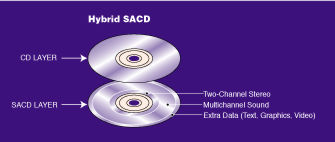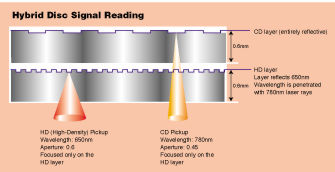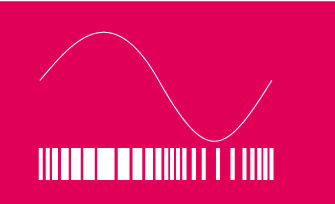The Bell Tolls for CD Page 2

The most common type of SACD is the hybrid disc, which offers at least one high-resolution track and a downmixed track that should play on any standard CD player.
DSD streamlines the process by directly recording the original 1-bit signal. The Delta-Sigma analog-to-digital converter uses a negative feedback loop to accumulate the audio waveform. If the input waveform, accumulated over one sampling period, is greater than the value accumulated during previous samples, the converter outputs a digital "1." If the integrated value of the input waveform is lower, a digital "0" is output. The digital-to-analog conversion on the back end of DSD can then be as simple as running the signal through the analog low-pass filter. Obviously, several steps are eliminated—most significantly, the decimation and interpolation filters and their requantization noise. The resulting DSD pulse train actually looks remarkably analog, and it's probably not a coincidence that many audiophiles have described SACD as the most analog-sounding of all the digital formats, new and old.
In case you were wondering how 1 bit and 2.8224 MHz ends up in anything other than a signal with a couple of dBs but a bandwidth of 1.4 MHz, the answer is noise-shaping Delta-Sigma modulation. DSD's high signal-to-noise ratios are achieved with fifth-order, noise-shaping filters that move noise out of the audio band by shifting them up in frequency; thus, the audio band's dynamic range is preserved. Is DSD simpler? It certainly looks it on paper. It is better? That debate rages on to this day and is something I'll explore in a future issue.

Both layers of the SACD are read from the same side. The CD pickup reads the CD layer through the semitransmissive high-density layer. The high-density layer is reflective for 650 nanometers and transparent for 780 nm, while the CD layer is fully reflective. The player adjusts the laser's wavelength to read the proper layer.
There are other advantages to DSD. Not only can the signal provide a wide bandwidth and a high dynamic range in the desired baseband, but you can actually select the tradeoff between the two during the production process. You can optimize some filters for bandwidth; others for low noise. DSD can also be downsampled to all the mainstream PCM sample rates, evidenced most plainly by the downsampled 16/44.1 DSD layer on an SACD. Because of DSD's high sampling rate and sampling periods that are only a fraction of a microsecond, processing delays—such as the unequal-signal-path delays in broadcast installations and the overdue delays in mixing consoles—are negligible. Tolerance to bit errors is also higher with DSD because, unlike with multibit PCM systems, no single bit is more important than any other.
Now, this may all seem like a lot of techno-babble and minutiae, but trust me—it matters. How much credence you choose to give it is up to you, but never underestimate its ability to affect your experience as you sit down in that easy chair, fire up your system, and settle in for a bit of sonic therapy.
SANB (Super Audio Nuts and Bolts)
DSD may get all the attention, but there's more to the SACD equation than coding. For starters, you've got to put those codes on something; for that, Sony and Philips have departed from current digital-audio standards. The most common SACD is a hybrid—one-sided but dual-layered (the Scarlet Book allows for single-layer, dual-layer, and dual-layer-hybrid discs). The semitransmissive layer of the hybrid disc is a high-density area with a capacity of 4.7 gigabytes (sound familiar?). This is where the separate high-resolution two-channel and six-channel DSD versions of the music track are placed. The inclusion of a high-resolution two-channel track is a major bonus for those of us who are quickly getting addicted to the sound of all that extra information but are only slowly getting used to multichannel music. Studios aren't required to offer a high-rez two-channel track—or a high-rez six-channel track, for that matter—but there will always be at least one high-resolution track. I'm keeping my fingers crossed that most producers will supply both versions. The outer rim of this layer has space for extras: onscreen lyrics, liner notes, artist biographies, TOCs, cover art, concert footage, music videos, and so on—the stuff I cynically referred to as marketing add-ons in the DVD-Audio piece, which is probably only half true. Of course, not all SACD players will have video circuitry, and the ones that don't will be unable to access video extras. This will be heralded by some listeners, who fear interference between the audio and video circuitry—no matter how well separated they are. However, if you're interested in these peripheral features, make sure you get a player than can exploit them.

The DSD pulse train (top) looks remarkably analog, while the PCM pulse train (bottom) has a more-common digital structure.
The disc's reflective outer layer offers a capacity of 780 megabytes (the same as CD), and this just may be the golden ticket to acceptance of SACD by the masses, including retailers. This layer will house a studio-downmixed, DSD-to-16/44.1-PCM version of the track, which means (you guessed it) backwards compatibility with every CD player on the planet. In theory, the potential of this addition is tremendous for the future of SACD. For instance, should the price of SACDs remain at or near that of regular CDs, retailers may only have to stock the SACD version of the disc (to avoid the dreaded double-stock). Even those without SACD players can buy them, play them on their old CD players, and enjoy what the SACD camp claims is a better-sounding PCM version, thanks to the DSD downmix. If people already have a lot of SACDs, which they can play in their old CD player, DVD player, boombox, etc., which high-resolution player do you think they're going to buy when it comes time for an upgrade? What remains to be seen, of course, is whether or not backwards compatibility with all CD devices will be foolproof. Obviously, there will be isolated incidents of incompatibility, but I've heard rumors of certain players that can't pick up the "CD" track of an SACD at all. I can't speak from experience, though, as the SACDs I've tried have worked without a hitch in car, portable, and other less-sophisticated players.




























































